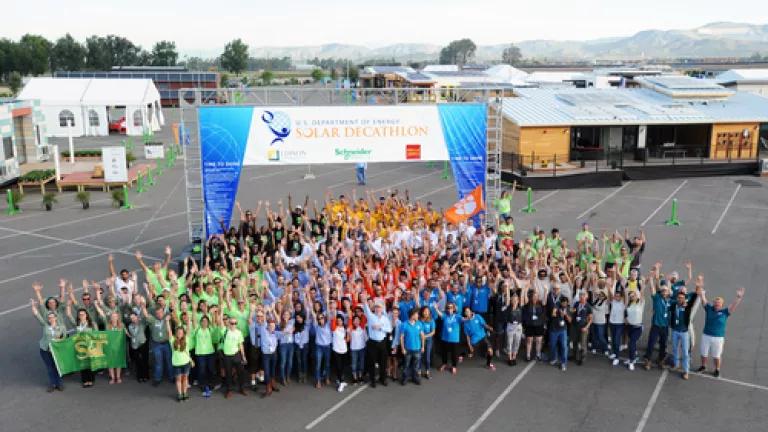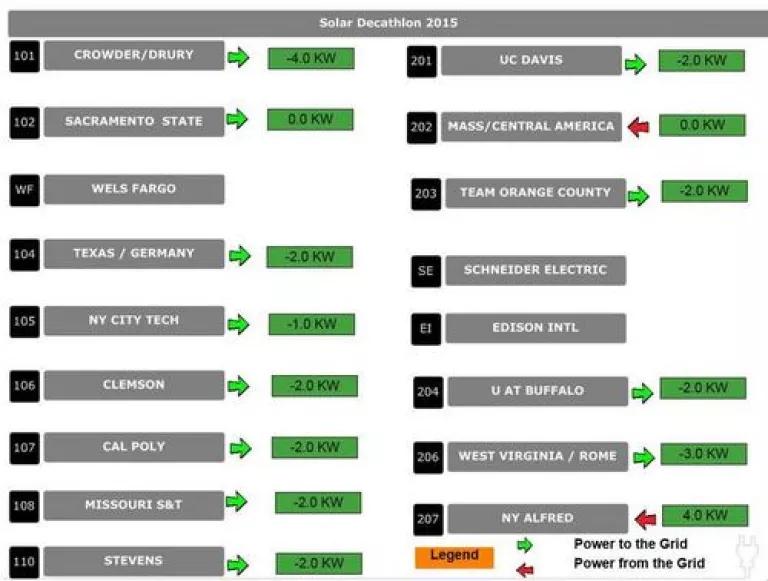
"This is a leadership program," said Richard King, Director of the US Department of Energy's Solar Decathlon last week as he surveyed the scene at Orange County, California's Great Park in Irvine. "It's a talent incubator. These are our next generation of energy leaders." There, on a giant tarmac, 14 teams from colleges and universities from across the country and around the world were putting the final touches on their net-zero energy homes, powered by the sun. Soon, they'd be entering a 10-event competition to see whose house was the most affordable, the most beautiful, the most efficient, the most innovative. (I'm putting my money on Team Crowder/Drury, by the way. But the quality of the competition is so high, who will win when the competition ends on Sunday is anybody's guess.)
Every two years, this event draws hundreds of thousands of visitors--everyone from school kids to high-profile architects, building engineers and designers. And it's known for advancing green building design and solar innovation everywhere.
(Photo credit: Thomas Kelsey/U.S. Department of Energy Solar Decathlon)
Clean energy policy and customer-utility partnerships are accelerating the deployment of climate solutions
By spurring cutting-edge architecture and building design and then putting it on display, the Solar Decathlon is one of several important ways the federal government helps speed the deployment of clean energy. Data monitoring is a case in point. When David Scheiren was the engineering lead for the New York Institute of Technology team in 2005--now he's the CEO of EmPower Solar in Island Park, New York--the National Renewable Energy Laboratory, "set up 100 sensors in our house that monitored our data every minute." That kind of data monitoring was new then. (The teams needed it to determine who would win in various categories.) "It taught us we needed that kind of data to maximize efficiency." Now, energy data monitoring is central to many energy efficiency and solar efforts. And such innovations aren't rare: the Decathlon has helped bring into the mainstream energy-saving LED lighting, heat pump water heaters, and triple-paned windows, among other green building components. "Usually, we're five to 10 years ahead of the market in these things," King said.
All of these clean energy technologies and monitoring devices are made even more powerful, so to speak, by the systems-based approach that the Department of Energy arranged for the village of these solar homes to interconnect to one another and the local utility. During the middle of a sunny day when the homes solar panels are producing at their maximum, the homes and entire village are providing clean electricity back to the local utility. The local utility then provides the bulk of the electricity needs when the sun begins to set and through the overnight hours. This arrangement defines a new level of partnership between the local utility and customers with rooftop solar. Policies like net metering have helped make this type of deeper utility-customer partnership a reality for over half a million U.S. homes and businesses to-date with rooftop solar. Additional policy approaches that build off the success of net metering are needed now to help bring all of the great energy innovations from these Solar Decathlon homes to market sooner.

Screenshot of the Solar Decathlon Village Energy Balance around 10:30 AM on Friday, October 16. A green arrow indicates the house is exporting solar to the utility grid while a red arrow means the house is taking in electricity from the local utility grid
Just as the Decathlon helps promote innovation, it intensifies the excitement team participants have about becoming leaders in the clean energy field. "I never would have been able to start a company without my solar decathlon experience," says Allison Kopf, whose start-up, Agrilyst, helps greenhouses and other indoor agriculture operations optimize their energy use and other inputs. (The platform recently won the prestigious TechCrunch Disrupt SF 2015 competition.) In Clarke Snell's University of North Caroline--Charlotte team, in 2013, "a lot of people were new to the idea of environmental construction," he says. And though adoption of solar and other kinds of green building in the Southeast has been slower than in other parts of the country, his former teammates, graduates now, are in design and construction firms "where they're the ones that bring it up in meetings."
We must take action to defend clean energy support policies that level the playing field
The Solar Decathlon shouldn't be seen only in isolation, though. The students who drive innovation through this world-leading competition need federal policy support, such as the soon-to-expire Solar Investment Tax Credit, to help prime the market for change and ultimately advance the field of solar energy and green building. (Clean energy tax credits also help level the playing field for pollution-free energy; we taxpayers, through the permanent tax code, have been subsidizing fossil fuels and nuclear power for decades.) "We have to have policies," Kopf notes, "that work for a more advanced and industrialized society."
Programs like the Solar Decathlon and clean-energy policies help create jobs, to be sure. "There was one company out here already," King reported last week, "that said to the students, 'I'll take every single one of you.'" But not only that; they help us combat climate change, give our kids cleaner air to breathe, save us serious money on energy, and help us to become leaders in the multi-trillion international clean energy marketplace.
Those are impressive accomplishments, the kind that can begin on an Orange County tarmac and spread the world over when government promotes leadership in clean energy.
